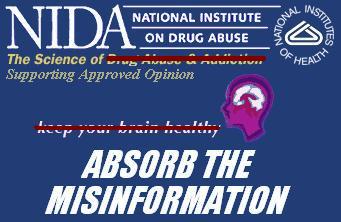|
|||||||||||||
|
By the National Institute on Drug Abuse Critique by Punkerslut
Effects on the Brain
Well, I'm glad that "increased heart rate" qualifies as "Effects on the Brain." The other effects on the brain were admittedly short-term. And finally, we end on a point that looks like it should belong in the "Addictive Potential" field. Of course the brain is going to respond wildly and rapidly when it is chronically exposed to something and then withdrawn from the object. Even our medical community is starting to recognize an enormous, clandestine population who are addicted to over-the-counter pain medications, such as acetaminophen and ibuprofen. [*1] Aspirin, caffeine, even refined sugars and television; if you pull something consistent out of someone's diet, it will definitely throw a wrench into their emotional and mental functioning. In Utrecht University, the Netherlands, the scientists of the Department of Bio-Organic Chemistry at the Bijvoet Center for Biomolecular Research have conducted experiments with Delta 9-THC in its efficiency with protecting against neuronal injury in neonatal rats. Their conclusion: "In summary, we have shown that in an in vivo model of neurodegeneration Delta 9-THC reduces neuronal damage via a CB1-receptor-mediated mechanism. This holds in both the acute and late phase after induction of excitotoxicity. Delta 9-THC inhibits astrogliosis via a non-CB1-receptor-controlled mechanism. The results strengthen the concept that the endogenous cannabinoid system may serve to establish a defense system for the brain." [*2] This research was left out. Beat Lutz and Giovanni Marsicano, of Max Planck Institute of Psychiatry and Johannes Gutenberg University in Mainz, have conducted similar experiments. Science Daily reported, "They said their discoveries suggest that the 'endocannabinoid' system might constitute a prime target for drugs against seizures of epilepsy and other neurodegenerative diseases." [*3] This research was ignored in this publication. NIDA is even forced to admit, "Thus, some cognitive abilities may be restored in individuals who quit smoking marijuana, even after long-term heavy use." Just some cognitive abilities, not all of them? Well, I'm glad that we're not giving the research too much credit. Effects on the Lungs
There is no use in denying that smoking marijuana can cause burning or stinging in the throat, or even a heavy cough. Inhaling any type of burning smoke particles into your lungs, whether from tobacco, sage, crack, marijuana, or adhesive glue, can cause serious irritation in the lungs and the pulmonary system. The report that is quoted ends on a rather open-ended note. Marijuana causes "abnormalities in the structure and function of alveolar macrophages" and "the available evidence strongly suggests that regularly smoking marijuana may predispose to the development of cancer of the respiratory tract." Also, it was determined that smoking Marijuana when you have Bronchitis isn't a good idea. Overall, though, the only hard conclusions of the report were that smoking crack-cocaine can have serious repercussions on the respiratory system, while Marijuana's negative effects aren't nearly as lethal or dangerous and much less consistent in their findings. In the second report, the determination of the researchers was, "The associations between marijuana use and head and neck cancer were analyzed by Mantel-Haenszel methods and logistic regression models. Controlling for age, sex, race, education, alcohol consumption, pack-years of cigarette smoking, and passive smoking, the risk of squamous cell carcinoma of the head and neck was increased with marijuana use." That is hardly surprising. Mixing birth control and tobacco can cause serious heart problems. Mixing Marijuana and tobacco can also cause serious health problems. The scientists have failed routinely in both studies to isolate marijuana use and a cause to cancer. Much less than a correlative link, they don't even have a circumstantial link! Aside from that, the University of California, Los Angeles published a study involving 601 patients with head and neck cancers and 1,040 people without cancer. There was not even a slight increased chance of cancer for individuals who smoked Marijuana, even those who used large amounts daily. [*4] This study didn't make it into the publication by NIDA.
The article by Sridhar KS and Raub WA was too obscure to locate. Even so, its claims are weak. Marijuana smoke may contain carcinogens, as the burning smoke of any material would. In Tobacco, it is the presence of radium, lead, and polonium in the fertilizer that creates the cancer-causing effect. In the study where heavy Marijuana use had no potential of increased cancer, the researcher theorized that THC can cause aging and damaged cells in the lung tissue to die before they can become cancerous. The researcher, Tashkin DP, was quoted by NIDA when it came to proving the link between marijuana smoking and coughing and phlegm production, but it didn't seem appropriate to quote him when he's drawing a clear link between THC and a potential cancer therapy. The other studies compare Marijuana's carcinogen levels to those of tobacco. This appears to be a constant trend of the article: to compare the dastardly effects of that devil-narcotic Marijuana to Tobacco. And we're reaching levels of "almost half as many more carcinogens," while leaving out the statement, "But unlike commercial tobacco, most clandestine marijuana growers don't use radioactive elements in their soil." That disparity between the production of marijuana and tobacco production should be one of the most important things for a national health organization to underline. There is another interesting part here. For one fact, the subculture of Marijuana users is considered: "Marijuana users usually inhale more deeply and hold their breath longer than tobacco smokers do, which increases the lungs' exposure to carcinogenic smoke. These facts suggest that, puff for puff, smoking marijuana may be more harmful to the lungs than smoking tobacco." Interesting, however, another part of Marijuana subculture is that the effects of this drug far outweigh those of tobacco. An individual who uses Marijuana may smoke only one or two joints a day, at most, as opposed to an individual who uses Tobacco, who may smoke twenty or thirty cigarettes in a single day. The habit is analyzed when it indicates a harm to Marijuana users, but not when it demonstrates a significantly reduced risk of bodily harm? The report even states that the damages of Marijuana match those of tobacco, "puff for puff." If a Marijuana user smokes two grams of Marijuana per week and a tobacco user smokes forty grams of tobacco per week, whose respiratory system is at greater risk for ill health effects? NIDA has not cited one study comparing cancer with those who smoke only Marijuana. The lack of evidence almost convinces me that they're actually waving a white flag on this point. Other Health Effects
This was an interesting quote and, as I soon found out, with much more interesting resources. I was a bit stunned when I looked up footnote 14, whose full resource is Adams IB, Martin BR, Medical College of Virginia, Virginia Commonwealth University, Richmond 23298, USA, Addiction 1996 Nov; 91(11):1585-614. Contrary to what the National Institute on Drug Abuse suggests, that paper reads, "Cannabis also has great therapeutic potential and has been used for centuries for medicinal purposes. However, cannabinoid-derived drugs on the market today lack specificity and produce many unpleasant side effects, thus limiting therapeutic usefulness." This is from the Abstract. Nothing was said about the limitations on the immunity system by the use of marijuana, but then again, I didn't have the $42.00 to blow on the full report. The fifteenth footnote is even more interesting. Given the format of its organization and the way it is used, one is led to believe that this is an experiment that proved the point in hand. Tracking back the resource, I found out that it was not a scientific experiment, but a single publication that denoted certain research projects. For the Marijuana section, there are a total of 41 different research experiments and their results. One study even demonstrated a decrease of lung infection after rats were injected with THC, and one part even states, "Other studies have demonstrated that THC enhances certain functions (Table 3). B-cell proliferation increased in the presence of THC at nanomolar concentrations (51), and the production of the chemokines MIP1{alpha} and interleukin-8 (IL-8); increased at micromolar concentrations (223)." What is left out of this publication are the recent studies by the University of California Los Angeles, which show that even massive quantities of Cannabis ingested through smoking, on its own, is incapable of producing lung cancer. [*5] Also in this "collection of experiments," the research done by H. B. M. Murphy, Dr. J. Kabelikovi, and those published in Krejci Pharmacie, have all been completely ignored. [*6] In one of these studies, Cannabis Indica showed the greatest promise for antibiotic use with over two thousands control subjects. In Madrid in February 2000, scientists reduced tumorous growths by injecting them with THC. Twenty six years earlier, scientists in Medical College of Virginia accomplished the same feet. [*7] Neither of these studies were included in the cited document of NIDA, despite their direct relevance to the issue at hand. What we're looking at is less and less a matter of intelligent researchers conducting experiments, but rather a matter of a tightly-controlled bottleneck of information that is slowly streamed out to the public in the most careful and poignant way, so as not to disrupt the host social system. In a phrase, academic censorship. When seeking to demonstrate the use of Marijuana medically, the Drug Enforcement Agency routinely denies research requests. [*8] NIDA pointed to an incomplete publication that shows even some validation to the theory that Marijuana has positive medical effects, and then this publication was used as a reference to the statement: "In other studies, mice exposed to THC or related substances were more likely than unexposed mice to develop bacterial infections and tumors." These are certainly some dishonest ethics for a publisher. Finally, there is the third study: injecting THC into mice with an injection of Legionella Pnuemophila. The amount of THC used in this experiment was 4mg per 1 kg of weight. In an adult human weighing 150 pounds (67.5 kg), this would mean 270 mg of pure THC, whereas the average smoking dose for this subject would actually be 2 mg. [*9] So maybe NIDA and I would agree here: it's probably not a good idea to inject yourself with a life-threatening bacteria and then to inject yourself with a dose of pure THC that would get 135 people high. It's true that animals require a somewhat higher dosage of drugs than humans on a mg per kg measurement, but 4mg per 1kg is ridiculously high. In the study conducted by H.B.M. Murphy (above-noted), it was demonstrated that THC's antibiotic activity is disabled when diffused through the plasma. Its only antibiotic effect is topical, to be applied to skin breaks, ears, nose, and throat. The experiment tested what was already previously demonstrated, without further applying the use of THC to where it has proven efficiency. I'm not going to blame the researcher, because there was nothing dishonest on their part. But to republish this study and argue that it indicates that Marijuana has no antibiotic effect is just another means of taking scientific findings out of their context in the scientific community. Furthermore, as one of the "collection of research papers" indicated itself: "Chemical extracts of marijuana contain over 400 compounds and more than 60 cannabinoids." These 460 different chemicals in Marijuana can effect the physiological response of the subject; they exist in varying quantities, types, and patterns, based mostly on genetic background of the plant, as well as growing conditions. Which cannabinoids were present is absolutely important, as the antibiotic activity of Cannabis is closely linked to CBD, CBG, CBC and their acids, rather than a THC group. [*10] Instead of looking at the situation and weighing these facts, NIDA has cast a blank check: Marijuana will give you cancer and destroy the immune system. Effects of Heavy Marijuana Use on Learning and Social Behavior
The resource cited in regards to anxiety and depression is not easily available. Even then, an organization that assumes the worst about any medical experiment has used the phrase "an association." Association and circumstantial evidence from obscure references? This demonstrates very little. At the Max Planck Institute of Psychiatry, mutant mice were bred without CB1 receptors in their brain, and compared to a control group, their ability to change fear-based behavior was lessened. [*11] Without the CB1 receptors, an individual is incapable of feeling either THC or its natural counterpart in the brain, endocannabinoids. Since THC mimics natural chemicals that bind to these receptors of the brain, these scientists theorized that Marijuana could be used as therapy for disorders as anxiety or post-traumatic stress. The second study that was quoted, done by Brooks JS, Cohen P, and Brook DW, actually only proved an association between drug use in youth and emotional disturbances. It's already well-known that addiction, whether of legal or illegal substances, can be one of the paths taken by those who seek an escape from natural stresses. In this study, there were no control groups to check for economic or cultural background -- in reading the determination guidelines of the participants, no consideration whatsoever is given to these factors. The study even made the conclusion that policy needs to change in accordance with the idea that removing drug use will remove these emotional disturbances. A similar study would probably find that those with low income usually spend less than those with higher income; I'm sure their researchers would refrain from the absurdity of "As a policy suggestion, poverty can be eliminated if we stop the poor people from spending less money than those with higher income." The reason why experiments need control groups is to determine whether outside variables might be influencing the results; that wasn't given consideration, so there is no logic in giving this experiment much value. "Research has shown that marijuana's adverse impact on memory and learning can last for days or weeks after the acute effects of the drug wear off..." This is interesting. For citation 19, subjects were supervised for abstinence for just about twenty hours before being given the tests. Even so, the effects were temporary, minor, and fully recoverable. In citation 20, the researchers came to the conclusion, "Impairments depended on the frequency of chronic marijuana use, i.e., 'light' and 'intermediate' marijuana use (defined by use one to four and five to six times weekly, respectively) were not associated with deficits. Intermediate use was associated with superior performance in one condition ('fuzzy' concepts) of a Concept Formation test." Those who smoke Marijuana 71% to 85% of the week demonstrate superior performance in concept formation tests. That's interesting. Well, I'm glad that this study was used as a reference to the statement, "research has shown that marijuana's adverse impact on memory and learning can last for days or weeks." The editors behind NIDA could use a toke or two to help their concept formation. For citation 25, the conclusion of that study was, " At days 0, 1, and 7, current heavy users scored significantly below control subjects on recall of word lists, and this deficit was associated with users' urinary 11-nor-9-carboxy-{Delta}9-tetrahydrocannabinol concentrations at study entry. By day 28, however, there were virtually no significant differences among the groups on any of the test results, and no significant associations between cumulative lifetime cannabis use and test scores." The mental impairment of daily, heavy use of Marijuana will last only a week or two when stopped. This is rather interesting, considering there are few other drugs, legal or otherwise, that hold true to the same fact. Instead, these conclusions are used for citation to the statement that Marijuana's mental effects "can last for days or weeks." While that is technically true, it's not considering that this experiment was for daily users of Marijuana who had used the drug at least 5,000 times. Then there's this statement: "Because marijuana compromises the ability to learn and remember information, the more a person uses marijuana the more he or she is likely to fall behind in accumulating intellectual, job, or social skills." Huh, where's the citation? Oh, that's just the editorial opinion of NIDA, which I assume would be based on their collected evidences. How come this fact doesn't take into consideration the improved cognitive functioning of intermediate users, even when that was one of the conclusions of a study they cited to draw this statement? How peculiar. Of all the studies that have been cited, those in the experimental group were drawn out from a population of those using Marijuana, so their conclusions will be more likely to tell us about the Marijuana subculture. Had their experiments drawn a fair and even participant group, and exposed half to Marijuana use, then there would be logical examination. Instead, it is drawing members out of the already existing Marijuana subculture and comparing them to other members of society with greater overall social advantages. It is an unfair comparison, and to confirm this, the differences between the using and non-using groups is only very slight, as opposed to the significant differences we should expect if NIDA's claims held true.
The policy of all public high schools is restrictive, coercive, and unfriendly to civil liberties. It is a prison sentence for the youth. There is nothing better for an intelligent mind than to be free, and not forced, in learning. It's not surprising that the student population with a significantly enhanced ability of concept formation would be the ones who first came up with the idea that their confinement is really just a type of slavery. Dropping out was one of the best decisions I've made. Of those who have high school credentials in the United States, 14% received them through the GED program. [*12] Testing those who smoke cannabis and who are confronted with an anti-drug program in their learning curriculum will naturally produce poor test results. All of the other studies have the same basic conclusion: the intoxicating effects of Marijuana are only slightly present for the days proceeding after daily, heavy, long-term use of Marijuana. Is that a vindication of Marijuana, or an indictment? The way it is worded, you would think that NIDA personally had something against Marijuana. No other widely used drug has that potential to be used frequently and in large amounts for years, but always allowing a return to complete normal brain functioning with only a few days of abstinence. Marijuana and the Worker
One of the factors not considered in these studies were the working conditions of the employees on a strapped budget. Eight hours of labor daily is enough to cause serious, permanent impairment of the mental, emotional, and physical faculties of any human being. [*13] As far as the research of workers in Capitalism goes, the well is poisoned. I would care to see a similar study of the effects of heroin injected every two hours into the eyes on children laboring twelve hours a day in a Nike factory. No one will be surprised if it increases death rates among the workers. When looking at these studies of increased illness, increased injuries, and increased disabilities, we have found a thousand variables, but nothing definitive about the misery of the laboring class. At the same time, the same researcher, Zwerling, published a report titled, "Occupational Risks Associated With Cigarette Smoking," which found workers who smoke tobacco to have increased risk of absenteeism by 33%, even when the researchers adjusted variables for age, gender, race, drug use, job category, and exercise habits. [*14] The study of Polen MR, Sidney S, and Tekawa IS was an interesting approach. It simply was a measurement of the use of healthcare services by patients, which found only slight increases by marijuana-smokers when compared with non-smokers. One could even logically conclude that marijuana-smokers take a greater interest in their health. It should also be noted that this study compared non-smokers with those who smoked only Marijuana daily. If there was a true and justifiable trend between Marijuana-smoking and ill health, shouldn't daily use demonstrate something more than just "elevated but not statistically significant" and "small increased risk"? [*15] It should be a very interesting fact that daily, long-term marijuana users were receiving just as many, if not more, examinations from physicians, without any of the life-threatening health effects that have been purported by the National Institute on Drug Abuse and Addiction. Why was this part of the study not quoted? Probably because it doesn't support the platform interests of NIDA and those agencies cooperating with it, such as the DEA and the FDA. There is one thing wholly unscientific about these investigations -- none of them had a control group where laborers were given fair or safe working conditions. Other than that, NIDA has demonstrated something very important: a distraction to an abused, overworked employee means increased absence and injury. I'll agree to that. The study quoted of Gruber AJ, Pope HG, and Hudson JI admitted that those in their "experimental group" had significantly lower educational background and income than those in the "control group." Their results were the same as my conclusion: the labor of the worker is the greatest determining factor of that laborer's health. NIDA can keep dancing around the idea that drugs are the greatest harm to the worker, or as a self-described "health agency," they can make policy suggestions to improve these conditions. The manner in which the National Institute on Drug Abuse has decided to make references is both unscientific, anti-literary, and a compromise of the publisher's ethic. They often just pointed to an extremely large body of work with mixed results for their resources. For all of the value that they add to their statements by adding these citations, they might as well have stated for their resource, "It's in books somewhere. Find one that validates this statement." It is astounding that it is a national health agency responsible for this publication. Punkerslut, Resources 1. "The 'cure' with a counter effect," Therapeutics Daily, Newcastle Journal - Feb. 27, 2007.
|



